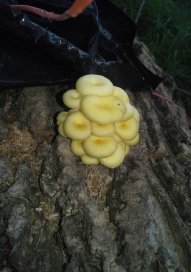AgEBB-MU CAFNR Extension
Green Horizons
Volume 20, Number 1
January 2016
Forest-grown Mushrooms for the Woodland OwnerBy Gregory O. Mori, Education and Outreach Coordinator, Center for Agroforestry
If you are a woodland owner or you run a small farm with a woodlot, growing mushrooms might be the right thing for you. Whether for commercial sale or personal use, cultivating forest-grown mushrooms in an agroforestry practice known as forest farming, can be an attractive and enjoyable activity.
As a woodland owner, it is always recommended that you develop and follow some form of forest management plan. Such a plan very likely will involve timber stand improvement (TSI), regular thinning of undesirable trees and occasional harvests of saw-grade timber. The low-grade and small diameter trees thinned from woodlots as well as branch-wood from tops of harvested saw-timber trees are often an ideal size to use for mushroom cultivation. Thus, it is possible to integrate a mushroom growing operation as part of an overall forest management program.
Mushrooms are the "fruiting bodies" of certain kinds of fungi. Many fungi obtain their food (energy and nutrients) from decaying organic matter like dead wood. These are called "saprophytic" fungi. The mushroom that you see is the "fruiting body" which is connected to unseen mycelium (tiny thread-like vegetative body of the fungi) growing in the dead wood. The mushroom is the site where spores are produced and released.
Some of the mushrooms that can be grown in a Forest Farming operation (one of five agroforestry practices) include: Shiitake, Oyster and Wine-cap (King Stropharia). Other lesser known and somewhat more challenging mushrooms to grow in a forest farming operation include: Lion's Mane, Reishi and Hen-of-the-Woods (Maitake). Besides being delicious and highly nutritious, many of these mushrooms command high prices at farmers markets and gourmet food establishments and can be the basis of a commercially viable forest farming operation. Through on-farm research, a Cornell University study found that growers can be profitable in year two and net $9,000 over a five-year period with a 500-log operation. Becoming "profitable" however, is relative and depends on how efficiently an operation is designed coupled with access to adequate markets.
 |
The basic growing techniques such as log inoculation, totems or wood-chip beds are relatively easy to learn, for either the backyard hobbyist or a commercial grower. You don't need much to get started, especially if you only plan to grow mushrooms for your own enjoyment. You will need access to some logs and a shady spot, some mushroom spawn and some basic equipment. A normal cordless drill can be used, but if you will be working with more than a few logs, investing in a high speed drill will make the job go much faster. White oak and sugar maple logs work best for Shiitake, but other species such as sweet gum work well too. Generally, just about any, 'soft" hardwood such as cottonwood or elm works great for oysters (as do many other substrates like straw, woodchips - even coffee grounds and rolls of paper). Wood chips of almost any deciduous tree species, mixed with straw, will provide Wine-cap mushrooms what they need to grow.
Generally, spores are not used in mushroom cultivation, instead logs or other growth substrates are inoculated with "spawn." Spawn consists of some sterilized growing medium (whether sawdust, grain or wooden dowel plugs) that has been colonized by a known and reliably producing strain of the mushroom (fungi) you are interested in growing. While it is possible for growers to produce their own spawn, until one has sufficient experience and adequate equipment and conditions, it is best to purchase spawn from a reputable supplier. Commercially available spawn comes in the form of plugs, sawdust or grain spawn. Plug spawn can be driven into drilled holes with a regular hammer. For sawdust spawn, a special inoculating tool is required that costs about $30.
Is mushroom growing for profit the right thing for you?
While growing common species such as Shiitake, Oyster or Wine-cap, is relatively easy to do, even for the backyard hobbyist, doing so profitably as a commercial mushroom growing venture, like most farming enterprises, presents many challenges. Adequate planning, a market survey and a thorough analysis of whether mushroom growing is right for you and your land is essential before diving in big. To get started as a hobbyist and learn "how" to grow mushrooms, there are many resources and grower guides available on-line (see links below). For launching a new enterprise, seek appropriate technical guidance from your local extension agent or other expert and do your homework before initiating a new commercial venture or introducing a new specialty crop into your farming operation.
http://extension.missouri.edu/explorepdf/agguides/agroforestry/af1010.pdf
